Born 1951 in Hartford, Connecticut; lives in Los Angeles, California
James Welling has long engaged a mediated—or in his own words, a “ventriloquist”— photographic practice that frequently takes photographic norms or the representational field itself as its subject. In the early 1980s Welling was situated alongside appropriation artists including Sherrie Levine, Richard Prince, and Cindy Sherman; they all eschewed claims of verist documentation (and the fantasy of transparency that subtends it) and modernist aesthetic autonomy in favor of deconstructive criticality. Perhaps best known for his early nonreferential studio photographs of such mundane materials as phyllo dough and aluminum foil, however, Welling—unlike his peers—has long investigated the possibilities of abstraction. The exposed chromogenic paper Degradés (1985–2008) recall Color Field painting; his Hexachromes (2005) render uncanny everyday spaces through aurora borealis–like eruptions of color.
An even more apt characterization of Welling’s practice might be that, as Rosalind Krauss contends, his photographs hold “the referent at bay, creating as much delay as possible between seeing the image and understanding what it was of.” Written in 1989 vis-à-vis his early works, this argument is equally relevant to the artist’s recent projects, including the Quadrilaterals (2006) and War (2005) series, both generated using Maya graphics software to create fields of shattered abstract shapes in which spatial confusions and perceptual ambiguities predominate. And while content is clear in his Glass House photographs (2007–08) of architect Philip Johnson’s renowned Connecticut home, the manner of one’s apprehension of it is not: using colored gels and lens flares, Welling physically intercedes in his visual images to create effects such as turning the green grass red (effects more typically rendered digitally today).
So too in Welling’s photogram series Torsos (2005–08) do complexities manifest. He cut screening, of the same type used for windows, to follow bodily contours and placed them on chromogenic paper before exposing them. Folded, curled, and billowing up from the paper ground, the wavy-edged mesh scraps produce lushly variegated passages while also revealing an obdurate materiality through their density, thickness, and permeability to light. Without being hostile to photography, Welling nonetheless has obviated traditional models of pictorialism. Tactility is privileged above opticality, as he turns away from perspective and optics to reground the medium in its fundamental bases of touch, pressure, and weight. (As has often been noted, photography literally means “drawing with light” and is not etymologically related to any mechanical means.) To cite Welling in a 2003 Artforum interview: “In retrospect, I see that there’s no escape from the history of photography.” SUZANNE HUDSON
James Welling, Torso 3, 2008. Chromogenic print, 57 1/2 x 47 in. (146.1 x 119.4 cm). Collection of the artist

























